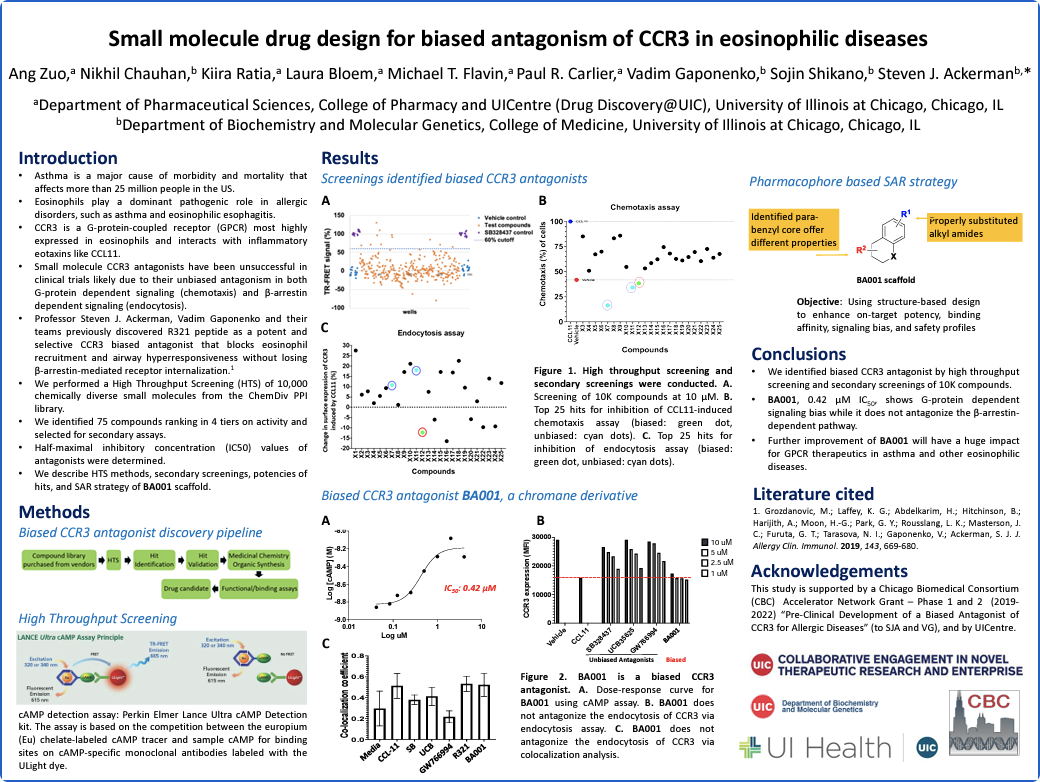Poster # 3
SMALL MOLECULE DRUG DESIGN FOR BIASED ANTAGONISM OF CCR3 IN EOSINOPHILIC DISEASES
Co-authors: Ang Zuo, UIC; Nikhil Chauhan, UIC; Kiira Ratia, UIC; Laura Bloem, UIC; Michael T. Flavin, UIC; Paul R. Carlier, UIC; Vadim Gaponenko, UIC; Sojin Shikano, UIC; Steven J. Ackerman, UIC
PRESENTER’S INFO:
Name: Ang Zuo
Email: azuo@uic.edu
Title: Staff Scientist
Affiliation: University of Illinois Chicago
Department: Biopharmaceutical Sciences and UICentre
Advisor: Dr. Paul Carlier
Advisor’s Email: pcarlier@uic.edu
Abstract:
CCR3 is a G-protein-coupled receptor (GPCR) expressed on eosinophils that interacts with epithelial-expressed inflammatory eotaxins (CCL11, CCL24, CCL26) leading to eosinophil recruitment into tissues and the pathogenesis of eosinophil-associated allergic diseases. Small molecule CCR3 antagonists have been unsuccessful to date in clinical trials, likely due to their unbiased mechanism of antagonism, inhibiting both G-protein dependent signaling (chemotaxis) and β-arrestin-dependent signaling (receptor endocytosis), leading to drug tolerance. Based on our successful development of a novel ‘biased’ peptide nanoparticle CCR3 antagonist termed R321 that inhibits G-protein signaling but not endocytosis (1), we herein report the discovery of novel biased small molecule CCR3 antagonists for the treatment of eosinophilic and other CCR3-mediated diseases. Using a lab-established cell-based High Throughput Screening (HTS) assay protocol based on CCR3/CCL11 Gαi-mediated control of cAMP production, we successfully screened 10,000 chemically diverse small molecules from the ChemDiv PPI library. We identified 75 compounds with >60% inhibition and selected the top 25 compounds for secondary ligand-induced assays for inhibition of chemotaxis and CCR3 receptor endocytosis to identify biased antagonist compounds that only inhibit chemotaxis. Half-maximal inhibitory concentration (IC50) values of the top-ranked antagonists were determined, and BA001, 0.42 µM IC50, showed G-protein-dependent signaling bias while it did not antagonize the β-arrestin-dependent endocytosis signaling pathway. Pharmacophore-based SAR strategy of the BA001 scaffold is currently under investigation to enhance on-target potency, binding affinity, signaling bias and safety profiles. Further improvement of BA001 will have a significant impact on the development of GPCR therapeutics for eosinophilic and other CCR3-mediated diseases.
Poster: To download / open the poster as a PDF file in a new window click on the image below.
No Fields Found.

